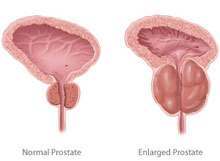Get the Facts About Prostate Problems

After the age of 40, men are susceptible to prostate problems. Prostate glands never stop growing in males, however this growth does not typically lead to issues until an advanced stage. More than 50% of men who have reached the age of sixty, and up to 90% of men who have reached the age of 80, experience symptoms of an enlarged prostate.
Prostate problems are uncomfortable to discuss for most men, as there are both intimate issues and problems with urination to be discussed. Even so, getting an enlarged prostate is not unusual. As men continue to live longer, an enlarged prostate is becoming more of an issue. In the year 2000, there were 4.5 million appointments made with doctors to address enlarged prostates.

What is an Enlarged Prostate?
As males age, there are two times when the prostate grows. The first time it gets bigger is when the male enters puberty and the prostate grows to twice its previous size. Then when males reach the approximate age of 25, the prostate begins to grow once more. This second growth phase can result in greater prostate issues down the road.
This is a very common condition, referred to by physicians as Benign Prostatic Hyperplasia (BPH), Benign Prostatic Hypertrophy, or enlarged prostate.
When the prostate grows, the tissue that encases the gland keeps it from expanding, which means the prostate begins to put pressure on the urethra. This, in turn, leads to thicker bladder walls. The bladder then starts to contract, regardless of the amount of urine contained in it. This contraction leads to an increased urgency to urinate. Over time, the bladder becomes weaker and is unable to fully empty during urination. The pressure on the urethra and the inability to fully empty the bladder can lead to complications of the enlarged prostate.
Prostate Characteristics and Functions
The prostate gland belongs to the male reproductive system. Its normal size is about that of a walnut, and consists of two lobes that are encased in a tissue layer. It is situated right under the bladder where urine is retained, in front of the rectum. In addition, the prostate encircles the urethra, which is the tube that allows for the excretion of urine from the body.
It is unknown exactly what all the functions of the prostate are. We do know that it serves to secrete a fluid into the urethra that mixes with sperm, as it prepares for ejaculation. The fluid that is produced by the prostate mobilizes the sperm and plays an important role in reproduction.
What are the Causes and Symptoms of an Enlarged Prostate?

Researchers are currently unable to pin down the definite cause of enlarged prostates. As such, the risk factors for BPH are largely unknown. It is well-understood that BPH shows up in men who are aging and that BPH does not show up in men who have their testes removed prior to hitting puberty. This is why scientists speculate that the aging process of the testes could be responsible for enlarged prostates.
The majority of the symptoms related to BPH are the result of the pressure on the urethra and the weakening of the bladder over time. There are many different symptoms, but the main ones are related to issues with urination. These include:
- 1. A weak urine stream or hesitancy in urination
- 2. Leaking of urine
- 3. Increased urination, particularly in the evening
- 4. Increased urgency

How is an Enlarged Prostate Diagnosed?
It is possible that a man will identify symptoms of an enlarged prostate in the course of living his life. It is also possible that a doctor will catch it during a routine health examination. If the doctor thinks he has BPH, he could refer the patient to a urologist for further tests. A urologist is a doctor who specializes in conditions related to the male reproductive system and to the urinary tract. There are numerous tests that can assist in the diagnosis of an enlarged prostate. Not every male will require every test, but here is a list of the most prevalent ones:
1. Digital Rectal Exam or DRE - This will most likely be the first test administered. The doctor will put a gloved finger inside the rectum to palpitate the prostate, which is adjacent to the rectum. This procedure will allow the doctor to determine how big the prostate is.
2. Prostate Specific Antigen or PSA Blood Test - This test is required to ensure that cancer is not present and responsible for the symptoms. PSA is a protein that is created by prostate cells and is often seen in higher levels in males who have prostate cancer.
The FDA or Federal Drug Administration recommends a PSA test be administered along with a digital rectal exam to diagnose cancer of the prostate in males who are at least 50 years old. It is also used to keep an eye on prostate cancer following treatment.
Keep in mind, there is still a lot to be learned about how to interpret PSA data, how to tell if the levels are increased due to cancer or due to BPH, and how to proceed once a higher level of PSA is detected.
3. Rectal Ultrasound - In the event that prostate cancer is suspected, a doctor could order a rectal ultrasound. This is where a probe is put inside the rectum to send sound waves to the prostate. These waves create an echo that allows a picture of the gland to show up on a monitor.
4. Urine Flow Study - On occasion, doctors will recommend this test to determine the rate of urine. Males urinate into a specially designed container and if the flow is slow or hesitant, it could serve to diagnose BPH.
5. Cystoscopy - This procedure requires the insertion of a tube into the urethra through the penis. The penis is numbed beforehand so the pain is eliminated. The tube is known as a cystoscope and is made up of a light and a lens that allows the doctor to view the bladder and urethra. The doctor can then see how large the prostate has become and find out how much of the urethra is obstructed.
References:
1 - The Official Foundation of the American Urological Association (AUA)







 Proaxil™'s formulation of effective ingredients and strong name recognition have brought praise from both customers and health professionals alike. To learn more about the research and data behind Proaxil™ , please visit our "
Proaxil™'s formulation of effective ingredients and strong name recognition have brought praise from both customers and health professionals alike. To learn more about the research and data behind Proaxil™ , please visit our "




